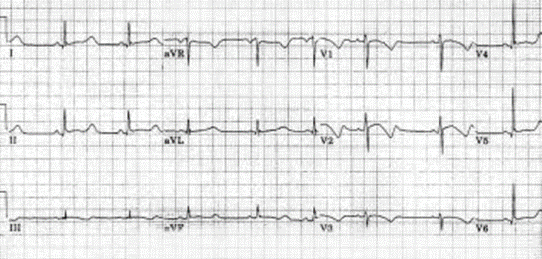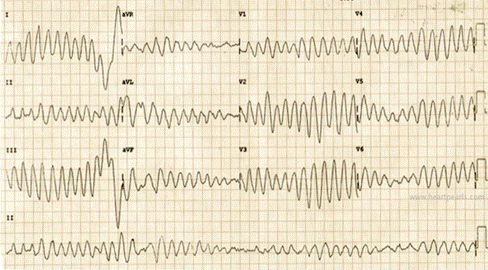Long QT Syndrome (LQTS)

Figure demonstrating an EKG with prolonged QT interval
The QT interval represents ventricular depolarization and repolarization. The QT interval varies with heart rate. The faster the heart rate the shorter the QT interval. The corrected QT (QTc) interval is calculated by dividing the measured QT in seconds by the square root of the preceding R-R interval in seconds. A corrected QT greater than 0.46 seconds is considered prolonged (Figure). In normal neonates, the QTc may be 0.50 seconds in the first few days of life.
LQTS is an inherited condition characterized by syncope, seizures, palpitations or sudden death. There are four different classes of patients with LQTS:
- Jervell and Lange-Nielsen syndrome, which is inherited in an autosomal recessive fashion and is commonly associated with sensorineural deafness.
- Romano-Ward syndrome, which is inherited in an autosomal dominant fashion and is not associated with deafness.
- Sporadic cases of LQTS have also been reported.
- The QT interval may be prolonged by certain drugs (Table), toxins and electrolyte imbalance.
|
Antipsychotics |
Antiarrhythmics |
Tricyclics |
Other antidepressants |
Antihistamines |
Others |
|---|---|---|---|---|---|
|
Chlorpromazine |
Quinidine |
Amitriptyline |
Citalopram |
Diphenhydramine |
Erythromycin |
|
Haloperidol |
Procainamide |
Doxepin |
Escitalopram |
Loratadine |
Clarithromycin |
|
Droperidol |
Disopyramide |
Imipramine |
Venlafaxine |
Terfenadine |
Quinine |
|
Quetiapine |
Flecainide |
Desipramine |
Bupropion |
|
Chloroquine |
|
Olanzapine |
Sotalol |
|
|
|
Hydroxychloroquine |
|
Thioridazine |
Amiodarone |
|
|
|
|
A table showing the common drugs which may cause QT prolongation
Pathophysiology
Congenital long QT syndrome may be caused by an imbalance of the sympathetic innervation in the heart especially the stellate ganglion or derangements in the cardiac ion flow, resulting in prolongation of the action potential. During the latter phase of the action potential, the myocardium is very excitable and may develop arrhythmia if stimulated electrically or mechanically. If a PVC occurs during this phase of the action potential (R on T phenomenon), a delayed after-depolarization develops in the form of a specific polymorphic ventricular arrhythmia (Torsades de pointes) (Figure).
Pathophysiology
Congenital long QT syndrome may be caused by an imbalance of the sympathetic innervation in the heart especially the stellate ganglion or derangements in the cardiac ion flow, resulting in prolongation of the action potential. During the latter phase of the action potential, the myocardium is very excitable and may develop arrhythmia if stimulated electrically or mechanically. If a PVC occurs during this phase of the action potential (R on T phenomenon), a delayed after-depolarization develops in the form of a specific polymorphic ventricular arrhythmia (Torsades de pointes) (Figure).

EKG showing Torsades de pointes
Clinical
Most patients are usually asymptomatic. Symptomatic patients present with episodic dizziness, palpitations, syncope, seizures, and/or cardiac arrest. Exercise, emotion and loud noises are triggers for prolonged QT conversion to other arrhythmias. Prolonged QT can convert to Torsades de pointes, bradyarrhythmias, or AV block.
Making the Diagnosis
- Clinical history.
- Family history of arrhythmia or sudden cardiac death.
- EKG: Corrected QT greater than 0.46 second (beyond the neonatal period), bradycardia, second degree AVB, multiform PVCs and T wave changes (T wave alternans, bifid T wave or biphasic T wave).
- Further testing: Holter or event monitors, stress test, provocative test with drugs, cold water face immersion.
Management
LQTS is a serious condition and the risk factors for sudden death include long QT > 0.55 seconds, family history of sudden death, bradycardia for age, and a prior history of symptoms. Any medications that may cause QT prolongation should be discontinued.
Treatment is aimed at preventing conversion to other possibly fatal arrhythmias. Beta-blockers are the mainstays of medical management. An implanted cardioverter-defibrillator (ICD) is often used as non-pharmacological treatment. Other non-pharmacological treatments include permanent dual chamber pacemaker and left cardiac sympathetic denervation.
Quick Check
Please complete the following questions


